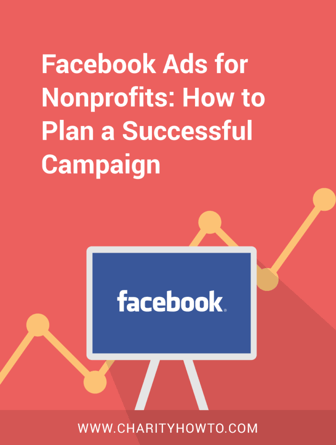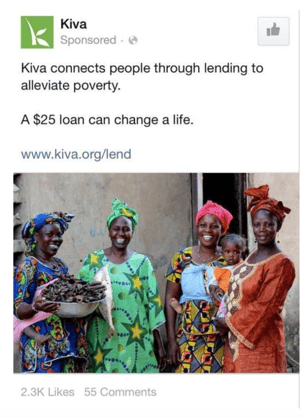
This is a guest post by Julia Campbell
Welcome to the wonderful world of Facebook advertising!
Facebook Ads for nonprofits, when created and launched strategically, can have powerful results for organizations looking to expand their online communities and raise more revenue.
With over 1 billion daily active users sharing 4.75 billion pieces of content every day on the social network, launching a Facebook Ad campaign can set you apart and help you reach a targeted audience.
This post is a simple guide to help you plan, create, launch, and measure a wildly successful Facebook Ads campaign to achieve your nonprofit’s objective, whether it be spreading awareness or raising money.
Let’s jump right into my 7 step plan for creating Facebooks Ads for nonprofits and getting your campaign off the ground.
Step 1: Set a Goal for your Nonprofit Facebook Ad Campaign.
Often I hear about nonprofits just clicking on the “Boost Post” button, or creating a generic Facebook Ad, with no plan or end goal in mind. That’s like flushing money down the toilet.
Before you create a social media advertising campaign, think about what you hope to accomplish. Do you want to increase donations? Blog readership? Event attendance? Email sign ups?
Social ads need a crystal clear Call-to-Action to be successful. Always be thinking about how you will measure the results of your paid advertisement – not in “goodwill” or “awareness raised” but in cold, hard numbers.
What is the goal for your Facebook Ad campaign? What will success look like?
Step 2: Set a Budget for your Nonprofit Facebook Ad Campaign.
You can achieve great results with a modest budget for social ads. All the platforms that offer advertising allow you to set a daily or lifetime budget, a total amount, and the dates and times you want to run the ad campaign.
The budget should reflect how many days you want to run the campaign, how many people you wish to see the ad, and what the results are worth to you.
If you spend $50 on an ad and get 34 new email newsletter sign ups, what is that worth to your nonprofit? It’s time to get data-driven in your marketing decisions, and paid social is a great way to start.
What is your lifetime budget for the campaign? What is your daily budget?
Step 3: Setup Your Facebook Ad Targeting.
Targeting your social nonprofit Facebook Ads is the most important part of the process. Without strategic audience targeting, your ad will fall flat and fail.
Facebook ad targeting can and should be hyper-specific. Dave Kerpen, CEO of Likeable Local, said:
“You know what’s cooler than reaching a billion people on Facebook? Reaching the right 1,000 people for your business, or the right 100, or the right 10 or the right one.”
Use the available tools to identify your key audience through location, demographics, interests, online behaviors and even other advanced targeting methods.

Answer the following questions about your nonprofit’s target audience: What is their location? Demographics? Interests? Behaviors?
Step 4: Use Visuals in Your Nonprofit Facebook Ad.

When starting a social advertising campaign, it is vital to have the right visuals. So what constitutes the “right” visual? One that resonates with your target audience and compels them to complete the desired action for you to reach your goal.
The four characteristics of a successful Facebook ad image are:
- simple and clear message
- contrasting colors
- text overlay/call-to-action
- 1-2 different fonts
Simple and clear design win over a cluttered, busy image every time.

Keep in mind that if you do overlay text on the image, Facebook prefers images with less text (text that takes up 20% of the image or less).
To the right are a couple examples of nonprofit ads that use strong visuals.
For more specifics on how to design a great nonprofit Facebook ad visual to accompany your campaign, read this post about how to expertly design Facebook ad images on DigitalMarketer.
What images can be used in this campaign to catch the eye, pique interest, and communicate the message?
Step 5: Write Copy for Your Ad.
Do not pay to put a half-baked, poorly-worded ad with a pixelated image out into the social universe! Choose your wording and your images very carefully.
Use graphics and other language that has worked in the past to engage your supporters and elicit a response.
Check over past email blasts, tweets, pins, photos and videos for the absolute best content to promote.
What wording should we use in this Facebook Ad campaign? Specifics and clear calls-to-action work best.
Step 6: Define the Call to Action (CTA) to Use In Your Facebook Ad.
Where I see many Facebook Ads for nonprofits failing is the number of obstacles in the way once someone clicks on the ad.
With the majority of social media usage taking place on mobile devices, your nonprofit’s Facebook Ad needs to be optimized for it. If the ad leads someone to your website, use Google’s free Mobile-Friendly Test to find out if the page is mobile-friendly.
Consider using landing pages in your ad campaign. Landing pages are specific webpages built to serve a specific objective – i.e. getting a donation.
What will happen when someone clicks on the ad? What action do we want them to take?
Step 7: Test & Improve Your Nonprofit Facebook Ad Campaign.
Social advertising is not a “once-and-done” kind of thing. If the ad campaign isn’t working or getting you the results that you expected, re-evaluate.
If you are not getting your desired results after 48 hours, consider what may not be working. Change the image. Wordsmith the ad copy. Sometimes the smallest tweak can make a huge difference in your results.
Some organizations run two or even three ads at the same time with the same objective and eliminate the ones that are not performing over a short period.
Consider the following questions: when will we evaluate the ad’s effectiveness? What benchmarks are we looking for?
***
Now, you have the seven steps to creating and optimizing your next Facebook Ads campaign for your nonprofit! Remember to keep your messaging clear, use powerful imagery, and give viewers a clear call to action to follow. With these steps, you are ready to create your successful Facebook Ads campaign.
